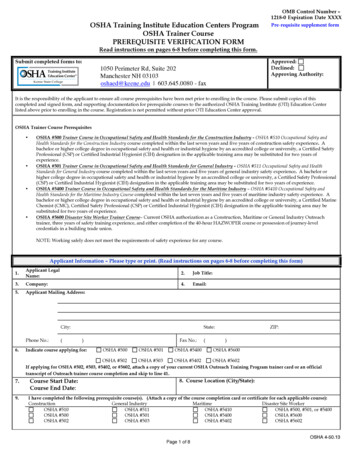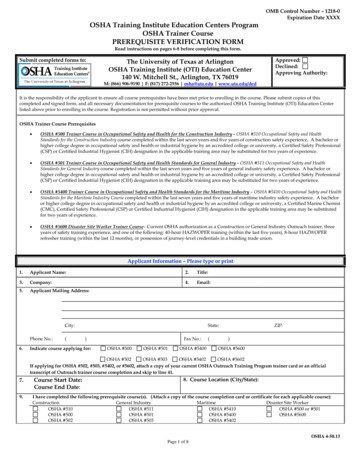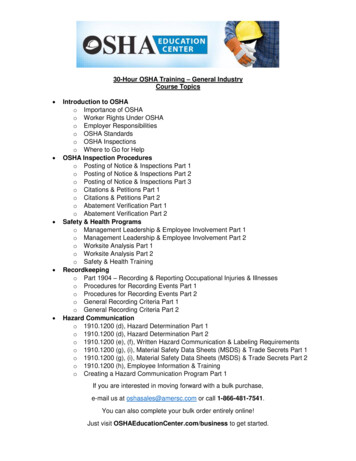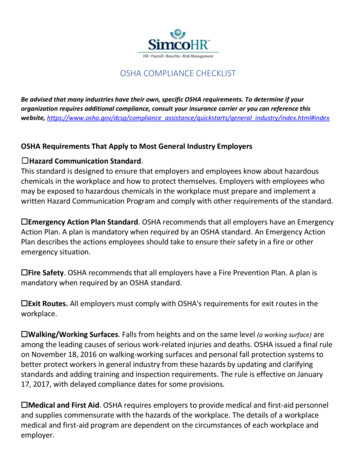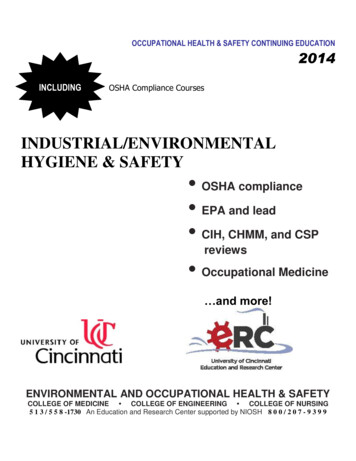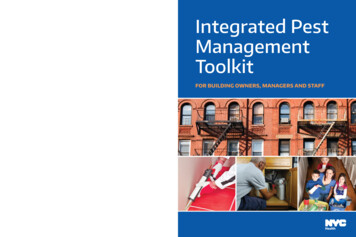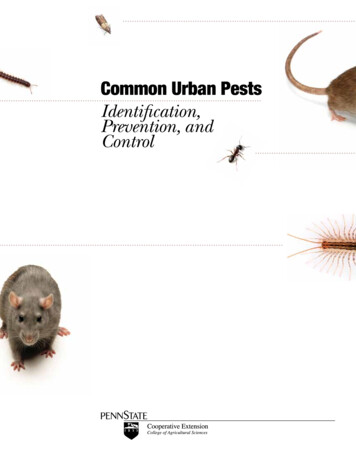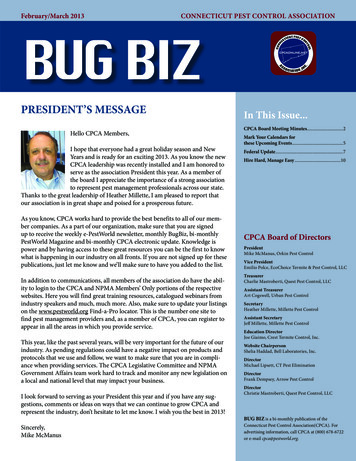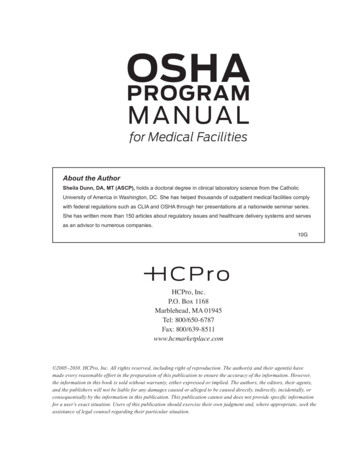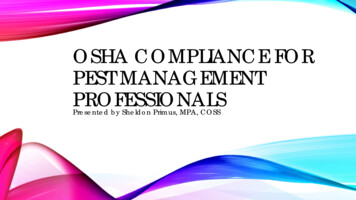
Transcription
OSHA COMPLIANCE FORPEST MANAGEMENTPROFESSIONALSPresented by Sheldon Primus, MPA, COSS
PRESENTER: SHELDON PRIMUS CEO/Owner of OSHA ComplianceHelp CEO/Owner of Utility ComplianceInc. Certified Occupational SafetySpecialist (COSS) Trainer for COSS program Authorized OSHA trainer for 10 & 30Hour General Industry andConstruction Safety Consultant
GUIDANCE FOR THIS DOCUMENTThis document highlights theprograms and OSHA complianceconcerns specifically for the PestManagement Professionals andgives compliance tips from aoccupational safety consultant.
Sign up for the OSHABi-weekly NewsletterQuicktakes to staywell informed onOSHA’s initiatives andcompliance activitiesTIP #1
TIP #2 KNOW YOUR SIC ANDNAICS CODES Standard Industrial Classification CodePest Control 0851 Forestry Services 2879 Pesticides and AgriculturalChemicals, Not Elsewhere Classified 7342 Disinfecting and Pest ControlServices
NORTH AMERICAN INDUSTRIALCLASSIFICATION SYSTEM (NAICS)CODE 115112 Pest Control Services, Agricultural 115310 Pest Control Services, Forestry 325320 Pest (e.g. ant, rat, roach, rodent) controlpoison manufacturing 561710 Pest Control (except agricultural, forestry)services 926140 Pest Control Programs, agriculture,government
USE YOUR SIC AND NAICS CODES TO LOOKUP OSHA COMPLIANCE HISTORY
USE YOUR SIC AND NAICS CODES TOLOOK UP OSHA COMPLIANCE .html
FREQUENTLY CITED OSHASTANDARD FOR NAICS: 561710
TIP #3 KNOW YOUR REQUIREDWRITTEN PROGRAMSFall ProtectionGeneral Safety and HealthHazard CommunicationLockout/TagoutPowered Industrial TruckRespiratory ProtectionEmergency Action Plan Must be written with 11 or moreemployees Fire Prevention Plan Must be written with 11 or moreemployees
TIP #4 USE JOB HAZARD ANALYSIS The job hazard analysis (JHA) is apractical tool used to help theworker to identify a hazard at eachstep of a task. Steps to a JHA are:1. Identify a task2. Break it into sequential order3. Identify hazards for each step4. Set a control for each hazardidentified at the individual stephttps://www.osha.gov/Publications/osha3071.pdf
CONFINED SPACE Confined Space is a: area that can have aperson in it, but notdesigned for people not meant forcontinuous humanoccupancy has limited orrestricted access andegresshttps://www.osha.gov/dte/grant materials/fy09/sh-18796-09/confinedspace.pdf
CONFINED SPACE CONTINUED Attics are considered confined spaces, however in a residential setting thePMP does not have to comply with confined space regulations. In a commercial application, the employer must protect the worker fromhazards associated with confined spaces. When a hazard exists in a confined space the area must be designated as apermit required confined space. Permit required confined spaces can be any space with: Configuration hazardEngulfment hazardEnvironmental hazard (such as extreme temperatures)Etc.
CONFINED SPACE CONTINUEDSteps for compliance:1. Don’t permit workers to enter a confined space without training and apermit.2. Have a procedure for entering a permit-required confined space.3. Identify hazards prior to entry and establish rescue procedures.4. During the entry test and monitor air and hazards.5. Seek to eliminate hazards and reclassify area to a general confined space.6. Maintain contact with entrant at all time with a watcher and two-waycommunication.
LOCKOUT/TAGOUT PROGRAM The lockout/tagout program is useto control release of hazardousenergy when performingmaintenance on equipment. Hazardous energy can be: malOther energy sourceshttps://www.osha.gov/OshDoc/data General Facts/factsheet-lockout-tagout.pdf
ns/OSHA3696.pdf
HAZARD COMMUNICATIONPROGRAMSteps for an effective hazard communication program:1. Learn the 29 CFR 1910.1200 Standard2. Prepare and Implement a written program3. Label all containers in accordance to OSHA or the Department ofAgriculture procedures. (Note: pesticides and fungicides fall under theEnvironmental Protection Agency (EPA) rules and not OSHA 29 CFR1910.1200(b)(5)(i)).4. Maintain current SDSs5. Inform and Train Employees of program and chemicals6. Evaluate and Reassess the program
HAZARDOUS MATERIAL Hazard material handling and cleanup is an important job for the PMPs. Workers exposed to hazardousmaterials must have initial training,field training, and an annualrefresher training in accordance to29 CFR 1910.120 to learn how toclean up spills.
PPE HAZARD ASSESSMENT Employers must have a WRITTENCERTIFICATION of a PPE hazardassessment to ensure that they areadequately protecting the workersfrom hazards that can not becontrolled through engineeringmethods (29 CFR 1910.132 Subpart I‐Personal Protective Equipment). A model PPE Hazard Assessmentcan be found on the Oregon OSHAwebsite.
MEDICAL EVALUATIONQUESTIONNAIREWorkers that have to wear arespirator for protection must havea medical evaluation and a fit testprior to having to wear arespirator.The medical evaluation asks aseries of questions to help thelicensed professional healthcareprovider to determine if the workeris fit to use a respirator.
PROPOSED RULE FOR FALLPROTECTION Exposure to employee ofheights of 4 feet or highermust be covered under afall protection plan. Currently, fumigatorswithout fall protection arein noncompliance withthe General Duty Clause5(a)(1)
FALL HAZARD ISSUES: Most Common OSHA solutions to height hazards: Scaffolding Fall protection systems with harnesses. Safety Nets Fall Arrest Systems Industry Response: Cost are Prohibitive OSHA Response: expense is NEVER an acceptable reason not toimplement systems to protect worker health & safety.
HORIZONTAL LIFELINE ANCHOREDTO ENDS OF RIDGELINE
SLOPED ROOF FALL ARREST SYSTEM Anchored at ridgeline and near roof edge
FALL PROTECTION CONTINUED
LADDER USE Issues of maximumweight on ladder Both hands must beused for climbing orworking from ladder Can’t carry anythingwhich might interferewith climbing ladder
HAND CRANK &MORE POWER LIFTS
SUMMARYIn summary: OSHA compliance is not only the law, but it’s theright thing to do in order to protect the workers frominjury. The direct and indirect costs for just 1 injury canamount to thousands of dollars to the company An effective Safety and Health program will reducecosts, lower workers compensation rates, andincrease worker productivity.
CONTACT INFORMATION OSHA Compliance Help 1-888-398-0120 ext. 102 Sheldon@OSHAComplianceHelp.com www.oshacompliancehelp.com Twitter @OSHACOMPHELP Facebookwww.facebook.com/oshacompliancehelp
115310 Pest Control Services, Forestry 325320 Pest (e.g. ant, rat, roach, rodent) control poison manufacturing 561710 Pest Control (except agricultural, forestry) services 926140 Pest Control Programs, agriculture, government. USE YOUR SIC AND NAICS CODES TO LOOK
